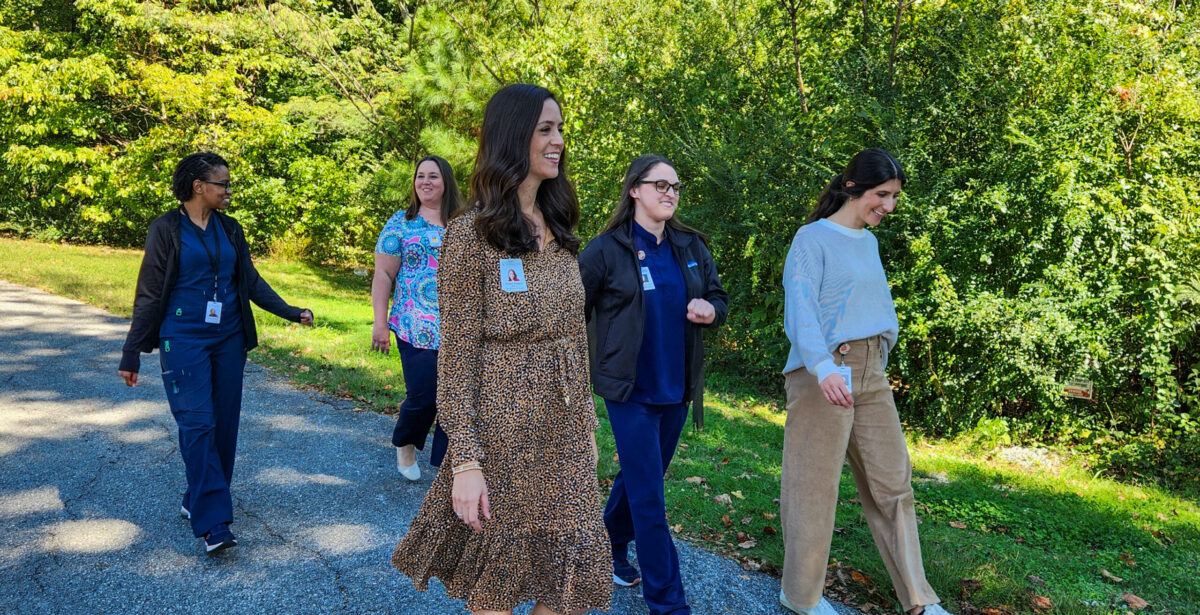What every Birmingham parent needs to know about speech and hearing milestones
Reading time: 5 minutes
Partnered Content

Being a first-time parent can be scary and overwhelming. As a new mom, I find myself constantly Googling what my baby should be doing when he reaches a certain age. Unfortunately, they don’t send you home with a manual after childbirth.
Language development is obviously crucial, and parents want to make sure their child is on track developmentally. We spoke with Missy Kemp, diagnostic audiology supervisor at Children’s of Alabama, about what parents need to look for regarding speech and hearing development.
What is the role of audiology? Why is it so important?

“We’re in the business of doing what it takes to get an accurate assessment of hearing and speech in children. Our department provides diagnostic audiology services, speech-language pathology, and is home to the Hear Center–the only multidisciplinary program in the state that provides cochlear implants, hearing aids, speech language pathology and auditory verbal therapy. The goal of our department is to help children reach their communication potential.”
Missy
Developmental milestones for speech and hearing

In the state of Alabama, infants get a hearing test within 24 hours of life. I remember being surprised when an audiologist showed up in my hospital room the morning after I had my baby. She put small earphones in my baby’s ears and ran a couple of tests–he didn’t mind at all! He passed his test, but it’s important to know that if a child does not pass this newborn hearing screening, they need to be rescreened by one month of age.
“We follow a one-three-six guideline. We screen at one month, diagnose by three months, and have an intervention plan in place by 6 months,” said Missy. This guideline was developed by the Joint Committee on Infant Hearing in 2007.
According to Missy, “That’s really when newborn hearing screening took off. All newborn children in Alabama should have a screening at their birthing place. We are able to diagnose hearing loss much earlier thanks to this requirement as well as advances in testing equipment.”
Below are the typical ranges for speech and hearing development. It’s important to note that all children develop at different rates, but these are the average milestones.
1 to 3 months: startle and smile
“Starting at birth, we would expect a child to startle to a loud sound,” said Missy. In the one to three-month range, a baby should be soothed or quieted by mom’s voice.”
At three months, babies should turn their head toward sound. They should also be awoken by loud noises. This stage is also when they may start to smile–one of the greatest joys a parent can experience!

6 to 9 months: name recognition
According to Missy, this is when babies really start to understand speech. They’re not ready to converse just yet, but they can understand simple words like “no” and “bye bye.” Babies this age really like toys that make sounds. They also turn to their name.
9 to 12 months: first word
Babies typically say their first word between nine and 12 months. By a year old, they can point to objects (for example, “where is the tree?” or “show me your shoes”).
18 months: movement to music
18-month-olds are ready to put their dancing shoes on. They LOVE music and moving to it. They also love stories and can point to body parts. 18 month-olds typically have a repertoire of 30 to 50 words.
2 years: short phrases
By two years of age, little ones have amassed a vocabulary of 300 words! (That escalated quickly). Once they have 300 words, they start to put them together with adorable phrases like “no want it.”
3 years: conversational speech
By the time they are three, children should be capable of conversational speech. Parents should be able to understand 75 percent of what their child says. Three-year-olds understand concepts like shapes and colors. They follow commands like “give me your cup” (unless they just don’t feel like sharing).
The significance of meaningful communication

“One of the most important things parents need to know is that communication begins at birth. Everything that is going into your child’s brain is meaningful. Talk to them during daily activities. For example, say ‘Here’s your soap’ during a bath, or ‘this is your fork’ at dinner.”
Missy
Screens don’t count
Screens simply cannot take the place of human interaction. It’s essential to promote real social interaction in young children. Paw Patrol might be adorable, but it won’t teach your child communication skills. By interacting with your child, you’re showing him or her nonverbal cues that are critical to overall communication development. There’s no give and take in a conversation with a screen.
Some behavioral concerns to be aware of
- When a child is using primarily gestures to request things and not using words at 18 months of age.
- When a child gets increasingly frustrated because they can’t make you understand what they need. They may act out behaviorally.
- Not making eye contact with parents or peers.
- Not responding when you make requests, like asking them to get their shoes.
When should you talk to your pediatrician?
You know your child better than anyone. If you think he or she is not meeting the milestones listed above, call your pediatrician. You can also call the Hearing and Speech department at Children’s of Alabama: (205) 638-9149.


 10988 views
10988 views
